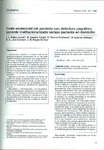Mostrar o rexistro simple do ítem
Coste asistencial del paciente con deterioro cognitivo: paciente institucionalizado versus paciente en domicilio
| dc.contributor.author | Millán-Calenti, José Carlos | |
| dc.contributor.author | Gandoy-Crego, Manuel | |
| dc.contributor.author | Sineiro Galiñanes, E. | |
| dc.contributor.author | Iglesias Gallego, M. | |
| dc.contributor.author | Lado Canosa, M.A. | |
| dc.contributor.author | Mayán Santos, José Manuel | |
| dc.date.accessioned | 2015-04-07T11:46:54Z | |
| dc.date.available | 2015-04-07T11:46:54Z | |
| dc.date.issued | 1999 | |
| dc.identifier.citation | Millán Calenti JC, Gandoy Crego M, Sineiro Galiñanes E, Iglesias Gallego M, Lado Canosa MA, Mayán Santos JM. Coste asistencial del paciente con deterioro cognitivo: paciente institucionalizado versus paciente en domicilio. Geriatrika. 1999;15(6):13-18. | es_ES |
| dc.identifier.uri | http://hdl.handle.net/2183/14354 | |
| dc.description.abstract | [Resumen] Introducción y objetivos: La mayor parte de las personas mayores permanecen en su domicilio cuando envejecen generando una carga asistencial a sus cuidadores difícil de cuantificar; por ello, el objetivo de este trabajo es tratar de conocer el coste generado por la asistencia directa a los pacientes con deterioro cognitivo institucionalizados, en relación con su estado funcional, a fin de poder establecer en base a ello el ahorro generado por los ancianos que permanecen en su domicilio. Material y métodos: Se registra el tiempo de asistencia directa al paciente por todo el personal asistencial durante 24 horas, en dos días no consecutivos, así como las actividades realizadas por los cuidadores familiares en relación al enfermo. Resultados y conclusiones: Los resultados, como era de esperar, evidencian una relación directa entre la capacidad funcional del anciano y coste asistencial; además se establece el coste por paciente en la institución, lo cual nos permite establecer el ahorro que los cuidadores familiares generan. | es_ES |
| dc.description.abstract | [Abstract] Introduction and objetives: Most elderly people remain in their homes as they become older generating an assistencial burden of thier carers which is difficult to quantify; as such, the objetive of this study is to attempt to ascertain the cost generated for direct assistence to patients with cognitive deterioration who are institucionalized, in realtion with their functional state, with the aim of being able to establish a baseline from which to compare the savings generated by the elderly persons who remain in their homes. Material and methods: The time taken employed in direct assistance to the patient by all persoanl assistants for 24 hours was registered, for two consecutive days, in as much as the activities carried out by the family carers regarding the patient. Results and conclusions: The results, as expected, demostrated a direct relation between functional capacity of the elderly person ans assistencial cost. Furthemore, the cost for the patient in the institution was established, allowing us to establish the savings generated by the family by caring for the patient at home. To conclude, the care of the elderly person in their own home should be encouraged by means of establishing appropiate programmes of support. | es_ES |
| dc.language.iso | spa | es_ES |
| dc.publisher | Liga de Geriatras y Gerontólogos de Lengua Latina | es_ES |
| dc.subject | Demencias | es_ES |
| dc.subject | Coste asistencial | es_ES |
| dc.subject | Cuidados profesionales | es_ES |
| dc.subject | Cuidado familiar | es_ES |
| dc.subject | Dementia | es_ES |
| dc.subject | Assistencial cost | es_ES |
| dc.subject | Proffesional caregivers | es_ES |
| dc.subject | Family carer | es_ES |
| dc.title | Coste asistencial del paciente con deterioro cognitivo: paciente institucionalizado versus paciente en domicilio | es_ES |
| dc.type | info:eu-repo/semantics/article | es_ES |
| dc.rights.access | info:eu-repo/semantics/openAccess | es_ES |
Ficheiros no ítem
Este ítem aparece na(s) seguinte(s) colección(s)
-
GI-GIGG - Artigos [114]






